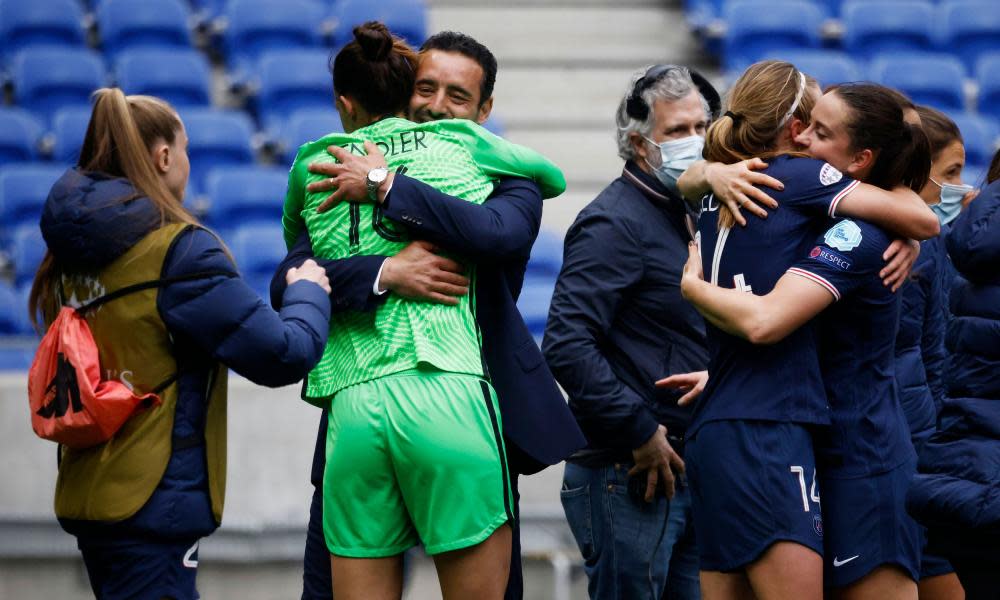European Super League could end up halting growth of women’s game

As the news of the planned launch of a men’s European Super League emerged and the outrage thundered, a quiet question from a smaller corner of the game was being asked: what would this mean for women’s football?
With women’s teams attached to all of the clubs involved in the plot to break away they would undoubtedly be affected. It would be impossible for the brinkmanship and animosity these proposals have engendered between European clubs to not spill over into the matters relating to their women’s teams.
So how will the women’s teams of the 12 rogue clubs get away with competing in the Champions League while their parent clubs step back from Uefa and the European Club Association? It is inconceivable to think that they will be able to.
Related: Super League players face World Cup and Euros ban, warns furious Uefa chief
“As soon as practicable after the start of the men’s competition, a corresponding women’s league will also be launched, helping to advance and develop the women’s game,” said the press release for the new European Super League. Reduced to a single sentence, with no further information on what that means or how it would work, it seems a foregone conclusion that the women’s teams will simply follow the men’s.
The problem is these 12 teams are not representative of the elite of European women’s football. They hold one Champions League trophy between them. The clubs of the three owners quoted in the press release, a trio understood to be driving this plan forward, have historically not been interested in women’s football. Manchester United’s women’s team is three years old, Juventus’s is four years old, while Real Madrid are playing their first season in the Primera Iberdrola.
Liverpool, drivers of the doomed Project Big Picture, which also promised big things for the women’s game in a single sentence, have built a new training ground with beach volleyball courts but no room for their women’s team, which has failed to earn promotion back up to the Women’s Super League after being relegated last season.
Meanwhile, Lyon – the champions of Europe, seven-times winners of the Champions League – and German champions Wolfsburg, twice winners of the tournament, currently sit outside the pack.
On a day when we should have been applauding the ratification of a new financial distribution model for the women’s Champions League, which is believed to include £10m from men’s Champions League teams, alongside the competition’s expansion to include a group stage and centralised broadcast rights, we have been looking at a plan that would cut the pioneers of women’s football in Europe out.
“I grew up loving the @ChampionsLeague,” tweeted the competition’s all-time top scorer and first winner of the women’s Ballon d’Or, Ada Hegerberg. “Then I got to play in the @UWCL. Then I got to win 5 of them and become the all-time leading goalscorer. It’s legacy. It’s the past, present, and future, so is meritocracy in sports. Greed is not the future.”
It is easy to see this as a glib inclusion of the women’s game, a token gesture to try and put a sheen on plans, except, if we are to assume the model will be similar to the men’s, then the effect on the women’s game could be crippling. The new masters of the European Super League have not, sources at some of the clubs have said, consulted the women’s setups about these plans and what they would mean. Instead they have been kept overwhelmingly in the dark.
Women’s football is just starting to find its feet from a commercial point of view and broadcast-wise. In England, on the 10th anniversary of the Women’s Super League, ambitions for the next decade were focused on sustainability and independence. These plans will halt that momentum.
Related: Premier League’s furious ‘Other 14’ look to derail Super League plan
Women’s teams will be tied to their parent clubs. The FA, which, in a joint statement with Uefa and a number of other European federations, strongly condemned the actions of the 12, will be forced to decide whether the women’s teams can continue in the WSL. The landmark broadcast rights deal, as a result, could be under threat if the leading teams in England are no longer a part of the equation domestically.
The ethos that has seen WSL clubs agree to give 25% of club revenue from that deal to the Championship will be dead. Meanwhile, discussions over the renewal of the historic Barclays title sponsorship of the league, which expires at the end of next season, will have significantly less value if the future of the major players is unknown.
How can these fledgling European leagues, and the women’s Champions League, continue to attract sponsors and broadcasters when at an unknown point in time, “as soon as practicable after the start of the men’s competition”, the women’s teams could be whipped from their remit?
What is clear is the conversation for women’s football should now be about independence and sustainability from a financial and governance point of view if it wants to avoid the sordid profit-driven path being trodden by the men’s game.
As it grows and becomes increasingly profitable, that will be harder to do, because women’s football will be increasingly used as a pawn in the corridors of power.

 Yahoo News
Yahoo News 
